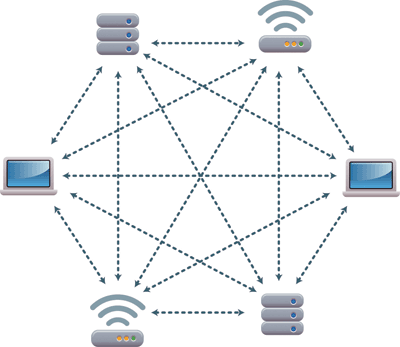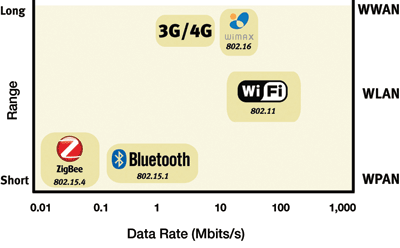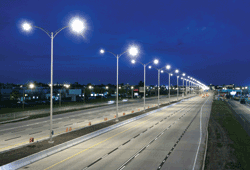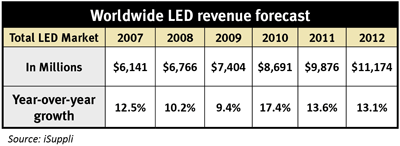New apps emerge with this low-cost, low-power technology
BY DAVID COHEN
California Eastern Laboratories
Santa Clara, CA
http://www.cel.com
ZigBee is a trademarked name and logo based upon the IEEE 802.15.4 standard, much like Wi-Fi is a trademarked name and a logo mark of interoperability for a set of technologies built upon the IEEE 802.11 set of standards. But ZigBee differs markedly from Wi-Fi, Bluetooth, 3G, WiMAX, and other wireless technologies.
Specifically, ZigBee was designed for short-range connectivity and controls, mesh, and very low power (see Fig. 1) . Most ZigBee products are battery powered only, with battery life measured in months, even years. Figure 2 provides an overview of how the technologies differ.

Fig. 1. ZigBee was designed for short-range connectivity and controls, mesh, and very low power.

Fig. 2. ZigBee differs markedly from Wi-Fi, Bluetooth, 3G, WiMAX, and other wireless technologies.
ZigBee reduces business expenses
The case for ZigBee in lighting control can be made on the convenience that ZigBee delivers and the new applications it enables but cost alone can justify the effort. Approximately 25% to 30% of a typical business office utility bill is lighting alone and intelligent lighting control can reduce that lighting expense by about 50% (Source: SmartMoney Small Business Web site. www.smsmallbiz.com/bestpractices/Cost_Cutters_Banish_the_Power_Bandits.html).
A ZigBee motion control sensor can turn the lights off when no one is in the office, cubicle area, conference room, cafeteria, hallway, or other areas. No one has to remember to turn the lights on or off. ZigBee also helps save cost through automatic dimming based on ambient light conditions. (see box )
Dimming lights reduces the energy draw, and while no one is suggesting people work in low light or poor lighting conditions, ZigBee-enabled sensors can be installed to sense the amount of natural ambient light and adjust the light fixtures accordingly. When there is enough ambient light from a window or other sources, the sensor activates the dimmer to adjust the lighting down accordingly. Of course, the automatic settings can be overridden where needed.
ZigBee also helps save time and cost in the installation of office lighting fixtures. Using ZigBee wireless controls, you can easily add new fixtures without pulling new wires. Instead of hiring an electrician to install new electrical wiring and dimmers, ZigBee-enabled lights can simply be plugged into any ac outlet and then controlled wirelessly by a ZigBee controller.
The controller can dim the lights, or turn them on or off either on command or by a preset program, for example, turning the lights on Monday through Friday, 8 a.m. to 6 p.m., and turning them off nights and weekends. Some ZigBee devices have TCP/IP (Internet) interfaces, enabling you to control lights remotely from any location, reducing energy use and saving money.
New applications
Parking Lots
Beyond office lighting, ZigBee is gaining a foothold in other key lighting applications. Both outdoor and indoor parking lots burn a lot of energy. Depending on the size of the lot, dozens or hundreds of lights are used, and for security reasons these lights often stay on all night even when no one is there.
To save on such unnecessary and expensive energy use while still preserving security, ZigBee-enabled motion control detectors can be installed that automatically turn off or dim the lights to 50% power when no one is there but quickly turn them back on to 100% brightness if someone arrives in the lot. On-site security staff or remote staff can also use ZigBee to override any automatic settings as necessary, dimming, turning on, or turning off any light in any area of the parking lot or other outdoor illuminated areas from a central control point.
Street and Highway Lighting
Municipal street and roadside lights consume a lot of electricity and contribute significantly to a city’s overall operational expense. ZigBee-enabled controllers can turn lights on and off on a set schedule and can dim or raise lighting based on ambient conditions (see Fig. 3 ).
The settings can be overridden from a remote location by a city manager, and zones can be set up so that each zone can be set independently from the other zones. Furthermore, ZigBee can automatically detect when a streetlight has burnt out and needs to be replaced, sending an automatic e-mail or SMS text message to a city manager.
This saves significant money when compared to sending a city employee periodically up and down every city block and down each highway to check and report on lights that need to be replaced. This also yields safety benefits, as the light can be replaced very quickly, rather than waiting for the next periodic city-wide inspection.

Fig. 3. A ZigBee-enabled controllers can turn on and off lights on a set schedule and can dim or raise lighting based on ambient lighting conditions.
Commercial Warehouses/Large “Box Stores”
Commercial warehouses and large stores like Costco and Walmart have significant lighting energy expenses as they illuminate enormous amounts of square feet in their stores. Turning lights on and off via ZigBee motion controllers or dimmers saves significant dollars. Areas of the warehouse or store can be logically segmented by zones with different policies applying to different zones. Policies can be reprogrammed and changed dynamically by store managers on site or off site.
Residential
Though currently limited to use in high-end homes only, ZigBee delivers some tangible benefits. Beyond saving energy, ZigBee makes it much easier to add, move, or reconfigure residential lighting because only a local power source is required. Lights can be dimmed or adjusted to fit any mood, by room or by zone, and zones can be reprogrammed at any time.
City Traffic Lights
ZigBee has several applications for city traffic light systems. A ZigBee-enabled traffic light can automatically detect bulb failure, which aside from the savings of reduced periodic inspections, delivers a tremendous safety benefit by dramatically minimizing the amount of time a traffic light is out of order. An automatic notification e-mail or SMS text message can be sent immediately to the city’s traffic department.
ZigBee-enabled traffic lights can detect traffic conditions and adjust the green-light/red-light durations accordingly. This can be as simple as turning a light from red to green when there is no cross-traffic or something more sophisticated such as adjusting the light durations based on the overall mix of traffic at any given intersection. Algorithms for traffic management can be programmed by urban planners and adjusted or overridden remotely at anytime. Traffic lights can also be dimmed or made brighter based on ambient lighting conditions, enabling the lights to be brighter on a sunny day while dimmer at night, increasing safety while saving energy.
For emergency vehicles, ZigBee may prove to be a significant breakthrough. With a ZigBee-enabled traffic light system, an emergency vehicle could transmit a special code that changes all traffic lights to green and stops all cross traffic. This would help get emergency personnel to their location much more quickly and gets the injured party to the hospital much faster, literally saving lives. It would also have a safety and life-saving benefit by reducing intersection collisions with vehicles that failed to see, hear, or yield to emergency vehicles.
Outdoor Billboards and Store Signage
ZigBee has a unique advantage in outdoor billboards, specifically dynamic signage that can change its display. Some billboards have a changing advertising message, for example, a dynamically changing lottery jackpot amount or other metric that regularly changes.
Since ZigBee can be bridged over TCP/IP to the Internet, the billboard’s advertiser can update the sign’s message anytime from anywhere, based on new information or a change of marketing strategy. For storefronts, store managers can change the outdoor or indoor store signage based on changing conditions in the store such as more or less shoppers or for any other reason. For a chain of stores, the changes can be made remotely from central headquarters and can be programmed to apply to all stores in the chain at once or to just an individual store.
A look to the future: ZigBee and LED lighting
We often think of light emitting diodes (LED) as the little blinking lights on your electronic equipment such as your cell phone, gaming device or home Wi-Fi router, and LEDs will continue to serve that purpose. But lighting an entire room through LED technology is starting to gain popularity. Research firm iSuppli has documented rapid recent growth and is predicting continued high growth in LED revenues, despite the economic slowdown (see Table 1). LED lighting is essentially lighting by a tiny silicon chip. LED lighting delivers benefit s in reduced size of the lighting element, increased brightness, reduced energy use, durability, lower total cost, lower heat and increased flexibility. Additionally, unlike another recent trend in lighting — compact fluorescent lighting (CFL) — LED lighting does not take time to warm up and more importantly does not require the use of nor have the significant hazards and disposal issues of the poisonous mercury contained in CFLs.

Table 1
New LED lighting applications include flashlights, accent lights in stores and restaurants, the internal illumination for new HDTV sets, and miniaturized projectors. LED lighting is also being phased in as a replacement for today’s everyday lighting, including incandescent and fluorescent lighting for homes and offices, and today’s mercury vapor and sodium vapor roadside and street lighting. Virtually any application where reduced size, reduced energy and better brightness are winning characteristics, LED lighting may stake a claim.
However, dimming an LED lighting fixture is different than dimming an incandescent light. Dimming for LED lights must be done electronically via a control signal inside the light fixture as opposed to lowering the voltage to the light as done in today’s incandescent lighting. In virtually all cases this will be done wirelessly and the control signal will come from a wireless mesh network device, typically ZigBee. A ZigBee device connected to or embedded inside the LED light would receive a wireless signal from a master control device the LED dimmer control –and would then dim the light to the desired setting. Through ZigBee, dimming can be done on command, automatically or dynamically with a preloaded program.
ZigBee can enable the “color tuning” of LED lights. This doesn’t mean changing it from blue to green but rather tuning the color temperature, a more subtle distinction, by adding more red or more blue in the white light. For example, in restaurants, food looks more pleasing to the eye in warmer, redder white light whereas jewelry stores may use LED lighting to bring out a diamond’s accents with colder, bluer light. This can be programmed over ZigBee.
These emerging trends show ZigBee and LED lighting to be natural partners and portend ZigBee helping LED lighting become the next great wave in lighting. ■
Box:
Technology Focus: How dimming works in LED lighting
Unlike incandescent lights which dim by lowering or raising the voltage to the light, LED lights do not actually dim. Since they are a light emitted from a semiconductor chip, they are either on or off. However, they can be programmed to emulate dimming. This is done by splitting the time cycle, measured in milliseconds (ms), or thousands of a second, into intervals where the light is on and off. For an LED light that’s on full brightness, the light is on all the time (see Fig. 4 ). For a light that is being dimmed to 50%, the light is turned on for half the cycle, then off for half the cycle, then back on at the start of the next cycle.

Fig. 4. LED lights do not actually dim, since they are a light emitted from a semiconductor chip, they are either on or off.
For a light that is being dimmed low to 10% brightness, the light is on during 10% of the cycle, then off for the remaining 90% of the cycle, then back on for the beginning of the next cycle. The reason the light does not look like it is flickering is because the cycles are so fast (thousandths of seconds) that the switches between on and off are not visible to the human eye. Inside the light, the LED semiconductor receives the instructions wirelessly from the ZigBee controller and changes the length of the on cycle time accordingly. And what we see is that the light is now “dimmed.”
Advertisement
Learn more about California Eastern Laboratories





